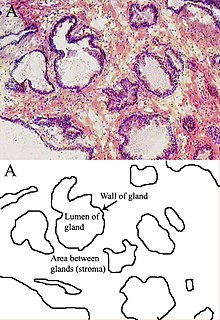Stroma (histology)
In animal histology, the stroma (from the Greek stor-/ster: 'extend', and strôma: 'tapeze') is the framework or framework of an organ, that is, its extracellular matrix (with its fibrillar components and ground substance) in addition to those connective cellular elements that synthesize the matrix. The stroma is reticular connective tissue. Classically, the stroma is considered as the support tissue or tissue support that fulfills the specific function of an organ. The latter is also made up of cells that make up the tissue called 'parenchyma'.
These concepts are based on bygone eras of Histology (with a morphological vision rather than a functional one), when connective tissue was assigned only the functions of support and cohesiveness, due to ignorance of "other functions&# 3. 4; of connective tissue. Currently the stroma-parenchyma interactions are being investigated, and it is understood that without such interactions (morphophysiological collaboration) both the parenchyma and the stroma lose their specificity. Isolated from each other, in tissue culture media, they lose their typical characteristics and survive for a short time. Thus, nowadays, it is understood that the stroma is as functional as the parenchyma and not only a supporting component.
Generalizing, the stroma is loose connective tissue; and parenchyma refers to the epithelial tissues and their endo-exocrine function. The stroma is a component of widespread distribution in organs and body systems.
The stromal component in the nervous system is known as glia. The glia fulfill a "connective function" for neurons (parenchyma) and is understood as stroma despite the ectodermal epithelial origin. This conception is, however, an excessively broad application of the concepts of parenchyma and stroma. They are almost metaphorical, since the aforementioned concepts were coined specifically for those organs that have supporting or connective tissue of mesodermal origin and a parenchyma made up of epithelial tissue usually of ectodermal or endodermal embryonic origin. Although this concept has exceptions in some organs that have an epithelial parenchyma of mesodermal origin (such as the kidney).
In the case of the nervous tissue of the central nervous system, both the neurons and most of the glial cells have an ectodermal embryonic origin. Only by extension is the idea that glia constitute or are similar to stroma used metaphorically. This is simply due to the fact that both, stroma and glia, have classically been considered only as structural support elements.
Contenido relacionado
Rhodopsin
Parapholis
Magnolia
